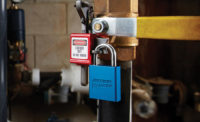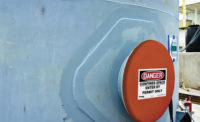Defining alternative approaches: Alternative approaches to lockout are protective measures created when it is not feasible to lockout because of the need for energy sources to be present in order to accomplish assigned work. Alternative measures can be used in well-defined procedures that protect workers from the risk of unexpected machine startup or the release of hazardous energy. Alternative approaches may include reliable control circuitry, blocking movement, safe working distances, or the use of shielding or reaching tools to prevent physical contact with dangerous areas of equipment.”
Benefits of alternatives: Alternative measures are beneficial because they allow for work to be completed that would otherwise not be done when lockout is applied because energy is required. Alternative measures can also provide some level of safety for an employee performing work that would otherwise be a great hazard to them if no measures were required in place of lockout.
Overused is a problem: Alternative measures are commonly overused in many workplaces as a convenience or excuse for not locking out. They are often poorly thought out and poorly resourced, or only token efforts are made to prevent the sudden release of energy. Alternative procedures done correctly demonstrate the precautions that must be taken to assure worker safety through a well-defined combination of engineering controls and administrative controls.
The 2016 ANSI Z244.1 standard global approach: The new ANSI standard takes an in-depth look at risk evaluation methodology and task-specific training and then requires verification that the alternative procedure is being performed as designed. This is closely aligned to risk control methods common to European and Asian regulatory requirements, resulting in a more “global approach.”
Sectional-type lockout: Sectional lockout is appropriate and safe when task assignments involve a specific area of a larger piece of machinery, or when task assignments involve a group of equipment. Applying full lockout to the entire mass of machinery may be unnecessary and inefficient. Sectional lockout identifies the energy sources affecting the immediate work area, as well as the energy sources affecting it from nearby operating functions. Lockout is applied to those sections only, rather than applying one all-encompassing lockout procedure.
Identifying tasks meeting alternative procedure requirements: It simply comes down to recognizing the impossibility or impracticality of performing the work that needs to be done when the machinery is in a fully isolated, zero energy state. If the work can’t get done because of lockout, alternative procedures should be used to ensure workers’ safety.
Alternative measures are commonly overused in many workplaces as
a convenience or excuse for not locking out.
Task hazard assessments: Whenever the need is recognized to perform a specific task with energy still present in the equipment, an initial assessment must be performed. If the initial control measures are not found to provide adequately safe working conditions, additional assessments are completed to improve the reliability of the methods required to do the task. If the task-assessment process cannot identify a safe and dependable way to perform the task, then full lockout is the only solution. Time must be taken to do the job with these protective practices in place. Once an alternative task assessment has been completed, it should be carefully documented and audited periodically to assure that the performance of the required precautions is fully compliant.
Documenting alternative procedures: Alternative procedures are documented whenever lockout is not an option because some energy is still needed to complete a task. They are documented separately for each task performed on a specific piece of machinery. There may be seven tasks necessary to keep a particular machine operational. Three of those tasks may require full lockout.Using this as an example, there would then be four separate alternative procedures documented for the remaining tasks to be completed with some energy still present. Once an alternative procedure is complete, it is usually only modified if the machinery changes, or if there is a failure of the procedure to adequately provide protection, resulting in an accident or near-miss scenario.
Essential elements of employee training: Workers should first be trained as authorized lockout personnel before being allowed to apply alternative procedures, so they understand the full protection offered by lockout in comparison to the alternative method of protection specified for the work they are performing. Then, workers should be trained–preferably hands on–on each alternative procedure they are required to perform. They must understand that the use of alternative measures does not entitle them to apply similar methods to other tasks where documented procedures do not exist yet or for tasks where they have not been trained yet.
Use of placarding to describe alternative procedures: Placarding certainly is the preferred method, and should be done whenever feasible, as long as harsh environmental conditions will not cause damage or degradation to the posted alternative procedures. However, the key is to properly train people on how to perform each alternative procedure they are being permitted to use, and to hold them accountable for proper performance through periodic verification inspections or auditing.
No excuses
It is important to remember that alternative measures are not a replacement for lockout procedures. There will always be some tasks performed on machinery where lockout will be the only possibility to protect those assigned to complete the work.
It is also important to note that alternative procedures, often used on problematic machinery, are also not a replacement for recognizing the underlying problem creating the need for troubleshooting. Eliminating these machinery tasks through engineering and design improvements take away the need for workers to be exposed to potential dangers, while also improving the efficiency and productivity of the working environment.
The new ANSI Z244.1 Standard; “Lockout Tagout and Alternative Methods,” due to be released in 2016, is a fresh look at the latest, evolving best practices addressing this demanding compliance requirement. A significant expansion of information and technical options related to the use of alternatives to lockout is highlighted.
Z244.1 remains committed to lockout as the preferred and primary means of worker protection during servicing, repair, troubleshooting and maintenance. But the standard also acknowledges a number of valid reasons some energy sources may need to remain present during specific tasks where the work could not be completed without it. Sometimes total isolation would eliminate critical safeguards. And there are other situations where risk can be reduced to a minimal and acceptable level through the use of highly reliable technology.



